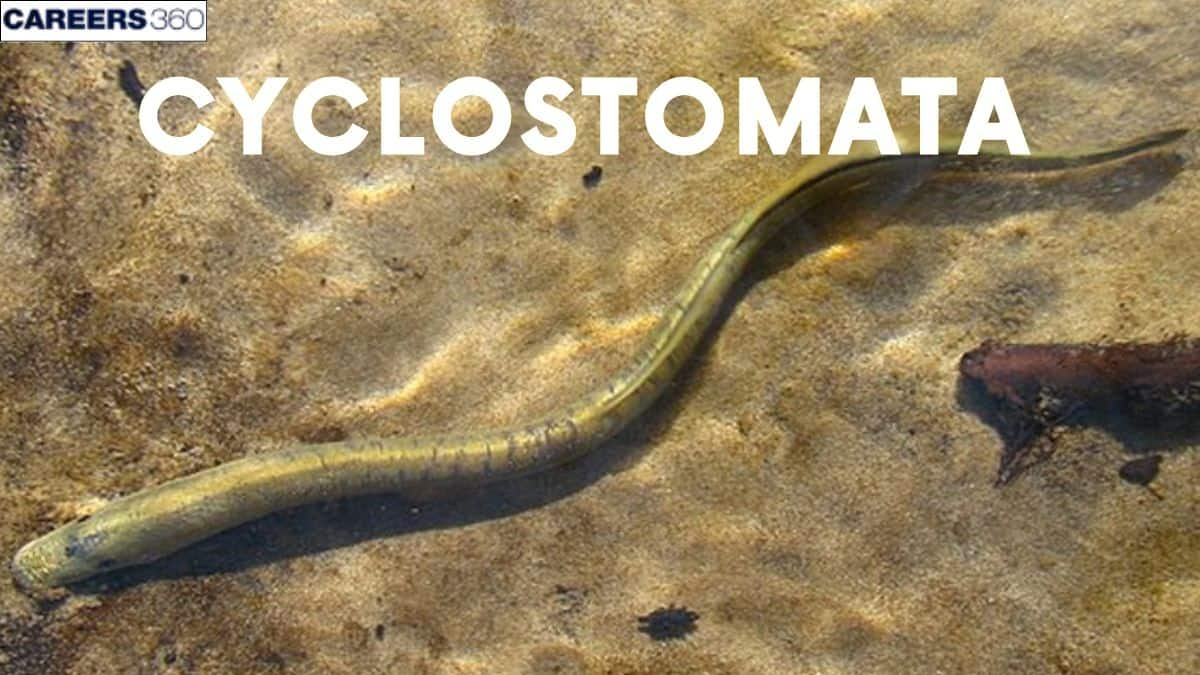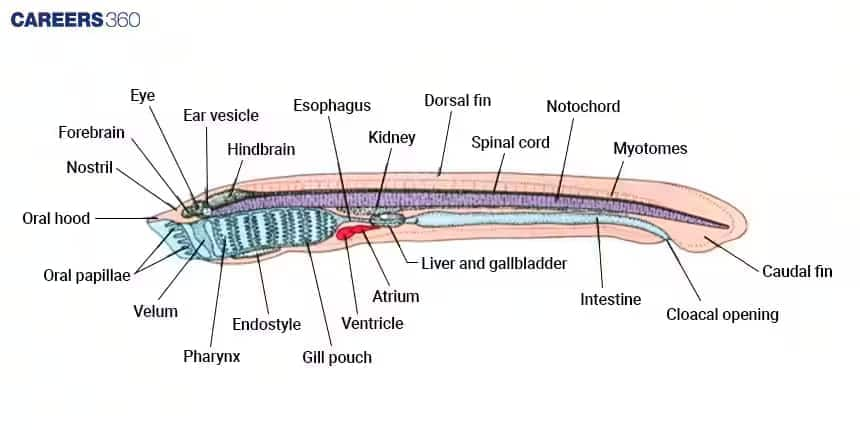Cyclostomata
Cyclostomata are primitive, jawless vertebrates like lampreys and hagfishes. They have sucker-like mouths, cartilaginous skeletons, and play key roles in vertebrate evolution. This guide explains their classification, characteristics, examples, and NEET exam notes.
This Story also Contains
- What are Cyclostomata?
- Taxonomy and Classification of Cyclostomata
- Origin & Evolutionary Significance
- Subdivisions of Cyclostomata
- Characteristics of Cyclostomata
- Anatomy & Physiology
- Habitat & Ecology
- Cyclostomata NEET MCQs
- FAQs on Cyclostomata
- Recommended video on "Cyclostomata"

Cyclostomata is a group of jawless vertebrates of the Animal Kingdom. They do not have jaws or paired fins. They use their mouth for either attaching to other fish or for filter feeding. Some of the common examples of cyclostomata include Lampreys and hagfish. These animals belong to the superclass Agnatha, which includes all jawless fish. Their skeleton is made of cartilage, not bone, making them more primitive than other vertebrates.
What are Cyclostomata?
The class Cyclostomata represents the jawless fish. It consists of two basic divisions. These are hagfishes (Myxini) and lampreys (Petromyzontida). These animals lack jaws and paired fins, which allows their study to be of major importance in understanding vertebrate evolution. Cyclostomes are among the most primitive living vertebrates, which help us to understand vertebrate development at an early stage.
Taxonomy and Classification of Cyclostomata
Cyclostomata is a superclass under the subphylum Vertebrata and includes two main living classes, Petromyzontida (lampreys) and Myxini (hagfishes). These are grouped together due to their shared jawless condition and similar morphology. The taxonomy and classification of cyclostomata are described below-
Kingdom | Animalia |
Phylum | |
Subphylum | |
Class | Cyclostomata |
Order | Myxiniformes (Hagfishes) |
Order | Petromyzontiformes (Lampreys) |
Origin & Evolutionary Significance
Cyclostomata are jawless vertebrates that represent one of the most primitive groups of living chordates. They are believed to have evolved from early vertebrate ancestors during the Paleozoic era. Below are a few points on the origin of Cyclostomata:
They are ancient vertebrates that appeared 500 million years ago during the early Palaeozoic era.
They evolved from early vertebrate ancestors and represent one of the most primitive forms of living vertebrates.
Cyclostomes are part of the Agnatha superclass, which means jawless fish, and they existed even before jawed fish evolved.
Their skeleton is made of cartilage and a simple body structure suggesting that they branched off early from the early vertebrate line.
Fossil records of ancient jaw fish help scientists trace the evolution of the vertebral column, nervous system, backbone, and brain.
Subdivisions of Cyclostomata
The group is mainly divided into two extant orders, Petromyzontiformes (lampreys) and Myxiniformes (hagfishes). It is based on differences in feeding behavior, reproductive methods, and anatomy. The cyclostomes are subdivided into two major orders.
Myxini (Hagfishes)
Hagfishes are soft-bodied, jawless animals that produce slimy mucus when disturbed, which helps them escape predators.
They are scavengers, meaning they feed on the bodies of the dead or dying animals by burrowing into them and eating from the inside.
Hagfishes live mainly in the marine environment and are rarely seen because they stay deep in the ocean.
Examples- Paramyxine and Myxine
Petromyzontida (Lampreys)
Petromyzon are parasitic, meaning attach themselves to other living fish using their sucker-like mouth and feed on their blood.
They have a tooth-like mouth to latch onto their host.
Lampreys are found in both freshwater and marine habitats, and some species even migrate between the two.
Examples- Lampetra and Petromyzon
Characteristics of Cyclostomata
Cyclostomes are jawless, eel-like vertebrates with a soft, elongated body and a circular, sucker-like mouth. They lack paired fins, jaws, and scales. Some general characteristics of Cyclostomata are discussed below:
Body Structure: The cyclostomes are characterised by their elongated bodies, eel-like in shape, with no paired fins, and no jaws. The mouth is sucker-like and circular.
Skeleton: They have cartilaginous skeletons, that is, they are made of cartilage rather than bone. They do not have true vertebrae, only a notochord. The notochord is a long, flexible, rod-like structure that tends to help support the animal.
Sensory Organs: The cyclostomes have rather poorly developed eyes and a lateral line system that detects vibrations and movements in the water. This enables them to steer through the water and to search for food.
Respiration: The cyclostomes breathe through gills, which are present in pairs of gill slits located on the sides of the head. These gills are used for aquatic respiration and are covered by a soft skin-like structure instead of hard gill covers.
Circulatory system: They have a closed circulatory system with a two-chambered heart. Blood flows in one direction, unlike higher vertebrates. The red blood cells are usually nucleated. The circulation is simple but efficient for their body's needs.
Nervous System: Cyclostomes have a simple but well-developed nervous system with a brain and a spinal cord. Their sense organs are adapted to their aquatic and parasitic life cycle, including a single median nostril and eyes that may be poorly developed in some species.
Reproduction: Cyclostomes are unisexual, meaning, male and female reproductive parts are separate. Fertilisation is external, and they do not have larval care. The reproductive cycle involves migration to freshwater for spawning, after which the adult usually dies.
Anatomy & Physiology
The cyclostomes have a mouth, gill slits and nostrils that help in respiration and eyes to help them see. The general anatomy and physiology of Cyclostomata are discussed below:
Mouth: Circular, sucker-like structure with keratinised teeth (particularly in lampreys).
Gill Slits: Multiple external openings along the sides of the body used for respiration.
Nostril: Single median nostril located on the top of the head, used for olfaction.
Eyes: Simple, lacking the complexity of higher vertebrates.
Fins (if present): Some species may have caudal fins for stabilisation during swimming.
Segmented Body: Cyclostomes have elongated, cylindrical bodies that are segmented.
Setae: Absent in cyclostomes, differentiating them from other segmented animals like annelids.
Clitellum: Not present in cyclostomes, unlike in annelids such as earthworms.
Habitat & Ecology
These cyclostomes inhabit a variety of habitats. Hagfishes are mostly deep-sea marine, while lampreys are found in both marine and freshwater systems. Lampreys also make very long migrations from one habitat to the other.
Ecological Roles:
Some of the species, like the hagfish, act as scavengers, devouring dead and decaying remains.
The impact that lampreys, particularly their parasitic forms, have on fish populations involves sucking their blood and feeding on tissues.
Lampreys can significantly affect fish populations, both through predation and parasitism.
Cyclostomata NEET MCQs
Q1. Which one of the following pairs of animals comprises 'jawless fishes'?
Mackerals and Rohu
Lampreys and hag fishes
Lampreys and Rohu
Lampreys and eels
Correct answer: 2) Lampreys and hag fishes
Explanation:
Jawless fishes are a group of primitive fishes that lack jaws. They are known as Agnatha, and the two main groups within Agnatha are lampreys (order Petromyzontiformes) and hagfishes (order Myxiniformes).
Lampreys and hagfishes both belong to the category of jawless fishes. These animals have evolved unique adaptations to compensate for the absence of jaws. Lampreys are characterized by their sucker-like mouth, which they use to attach to other fish and feed on their blood and body fluids. Hagfishes, on the other hand, are known for their ability to produce copious amounts of slime as a defense mechanism.
Hence, the correct answer is option (2) Lampreys and hagfishes.
Q2. A jawless fish, which lays eggs in fresh water and whose ammocoetes larvae after metamorphosis return to the ocean is :
Myxine
Neomyxine
Petromyzon
Eptatretus
Correct answer: 3) Petromyzon
Explanation:
Petromyzon(the lamprey) belongs to the section Agnatha of the sub-phylum-Vertebrata. They have long, greenish-brown, cylindrical bodies with smooth scaleless, slimy skin, jawless mouths, etc. They lay eggs in freshwater but their ammocoete larvae(lower) after metamorphosis return to the ocean.
Hence, the correct answer is option (3) Petromyzon.
Q3. Cyclostomata has an elongated body bearing 6-15 pairs of gill slits which help in
Respiration
Digestion
Excretion
All of these
Correct answer: 1) Respiration
Explanation:
Cyclostomata is characterized by jawless fish like lampreys and hagfish with specific anatomical characteristics.
Body Shape: They have a long body that usually carries 6 to 15 pairs of gill slits to respire. The gill slits are important in exchanging gases in aquatic conditions.
The cartilaginous cranium and vertebral column of a cyclostome are composed primarily of cartilage and they maintain a persistent notochord, which gives it support throughout their life cycle. These characteristics point to the unique evolutionary adaptations of Cyclostomata within vertebrates, which differentiates them from other fish groups.
Hence, the correct answer is option (1) Respiration.
Also Read:
FAQs on Cyclostomata
Which organisms are included under Cyclostomata?
Cyclostomata include organisms like Lampreys and hagfishes. Lampreys belong to the genus Petromyzon or Lampetra, and hagfishes belong to the genus Myxine or Paramyxine. Lampreys are parasitic animals that attach to other fishes and feed on the blood. While, hagfishes are scavengers that feed on dead or dying animals by burrowing into them and eating from the inside. These two groups together represent the jawless vertebrates of today.
What are the main differences between Lampreys and Hagfishes?
Lampreys are generally parasitic in nature. They attach to the body of fishes using their sucker-like mouth and feed on blood and body fluids. Hagfishes are scavengers, feeding mainly on dead and dying animals by burrowing into the body and feeding from inside.
Hagfishes can secrete large amounts of slime for defense, whereas lampreys lack this ability.
Do Cyclostomata have jaws and paired fins?
Cyclostomata, as their name suggests, have a round and sucker-like mouth. This circular mouth may be armed with sharp teeth made of keratin, especially in lampreys, which helps them to grasp the flesh of the host. They lack jaws, paired fins, which are characteristic of higher fishes. Instead, they have an eel-like body and possess only median dorsal and caudal fins.
Why are Cyclostomata considered primitive vertebrates?
Cyclostomata are considered primitive because they lack jaws, paired fins, and bony skeleton. Their notochord persists throughout life, and their skeleton is cartilaginous. They have a closed circulatory system and the blood flows in one direction. The respiratory system is simple compared to higher vertebrates. Their larval stage (ammocoete) also resembles early chordates. Hence, they represent one of the earliest stages of vertebrate evolution.
Recommended video on "Cyclostomata"
Frequently Asked Questions (FAQs)
Lampreys reproduce sexually, with external fertilisation occurring in freshwater environments, where they lay eggs that hatch into larvae.
